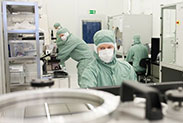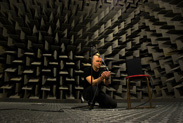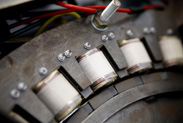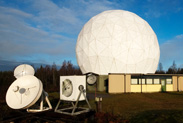Departments and units
The School of Electrical Engineering consists of four departments and two special units.
Department of Electronics and Nanoengineering
 Department of Radio Science and Engineering and the Department of Micro- and Nanosciences merged and begun operations on 1 January 2017. The new department is Department of Electronics and Nanoengineering.
Department of Radio Science and Engineering and the Department of Micro- and Nanosciences merged and begun operations on 1 January 2017. The new department is Department of Electronics and Nanoengineering.
The electronic circuit design and microfabrication research studies and develops integrated microcircuits for data communications and sensor applications. The research focuses on radio communications technology, radio controlled intelligent sensors and neural computing in image processing. Micronova is a national research infrastructure conducting research on many future components such as optical fibres and waveguides, LEDs, detectors, microsystems, nanostructured surfaces and fluidics.
The department carries out research and provides education on microwave and millimetre wave techniques and measurement, antennas, radio wave propagation, artificial electromagnetic materials, computational electromagnetics, circuit theory, and space technology.
The head of the department: Professor Jussi Ryynänen
- Department website (ele.aalto.fi)
Department of Signal Processing and Acoustics
 Research in the department focuses on audio signal processing, communication acoustics, speech communication technology, signal processing for wireless communications, optical radiation measurements as well as sensor array and multi-channel signal processing. In many of these areas, the research conducted in the unit is of highest international quality and the research groups cooperate closely with several ICT and other high-tech companies.
Research in the department focuses on audio signal processing, communication acoustics, speech communication technology, signal processing for wireless communications, optical radiation measurements as well as sensor array and multi-channel signal processing. In many of these areas, the research conducted in the unit is of highest international quality and the research groups cooperate closely with several ICT and other high-tech companies.
The head of the department: Professor Jorma Skyttä
- Department website (spa.aalto.fi)
Department of Electrical Engineering and Automation
 The department of Electrical Engineering and Automation began operating on 1 January 2014. It represents the merger of three departments: Automation and Systems Technology, Electronics and Electrical Engineering. All three departments have had significant shared research interests and have worked with common industrial partners.
The department of Electrical Engineering and Automation began operating on 1 January 2014. It represents the merger of three departments: Automation and Systems Technology, Electronics and Electrical Engineering. All three departments have had significant shared research interests and have worked with common industrial partners.
The four research focus areas of the department are as follows:
- Power systems and conversion
- Control, robotics and autonomous systems
- Wellbeing and a smart living environment
- Industrial electronics and informatics
The area of wellbeing and a smart living environment includes topics like health technologies and illumination engineering. The focus areas of the department are well in line with the School of Electrical Engineering’s focus areas.
The head of department: Professor Jorma Kyyrä
- Department website (eea.aalto.fi)
Department of Communications and Networking
 Comnet is the largest unit of research and higher education in its subject area in Finland. Comnet develops the fields of communications theory, information theory, and teletraffic theory, carries out both fundamental and experimental research in communications and networking technology, and finally applies the technological knowledge to research on networking business and human aspects of communication and communications technology. Comnet is an internationally recognised force in shaping the Internet technology.
Comnet is the largest unit of research and higher education in its subject area in Finland. Comnet develops the fields of communications theory, information theory, and teletraffic theory, carries out both fundamental and experimental research in communications and networking technology, and finally applies the technological knowledge to research on networking business and human aspects of communication and communications technology. Comnet is an internationally recognised force in shaping the Internet technology.
The head of department: Professor Riku Jäntti
- Department website (comnet.aalto.fi)
Metsähovi Radio Observatory
 Metsähovi Radio Observatory is a separate institute of the faculty. Located 35 km west of the Otaniemi campus, it operates a 14m radio telescope for millimetre and microwave astronomy. Its scientific research focuses on active galaxies, solar astronomy and very long baseline interferometry. The Metsähovi R&D covers computational engineering, wide-band data acquisition, high-speed networking and new radio astronomical instrumentation.
Metsähovi Radio Observatory is a separate institute of the faculty. Located 35 km west of the Otaniemi campus, it operates a 14m radio telescope for millimetre and microwave astronomy. Its scientific research focuses on active galaxies, solar astronomy and very long baseline interferometry. The Metsähovi R&D covers computational engineering, wide-band data acquisition, high-speed networking and new radio astronomical instrumentation.
Director: Joni Tammi
- Metsähovi website (metsahovi.aalto.fi)
Aalto Nanofab / Micronova
Micronova is Finland's National Research Infrastructure for micro- and nanotechnology, jointly run by VTT Technical Research Centre of Finland and Aalto University. Aalto's part of Micronova is called Aalto Nanofab.
Nanofab's mission is to develop innovative, enabling technologies, and to apply these in practical micro- and nanosystems. Micro- and nanotechnologies offer solutions, e.g., for energy efficiency and renewable energy technologies.
In the School of Electrical Engineering, Micronova facilities are used by departments of micro- and nanotechnology, radio science and engineering, and electronics.
Director: Mika Koskenvuori
Research areas:
- New materials: nanomaterials, electromagnetic materials
- Energy: solar cells, energy harvesting with thermoelectric materials, LEDs
- Health and wellbeing: bioadaptive electronics
- Microelectronics: MEMS, sensors
Micronova website (micronova.fi)

